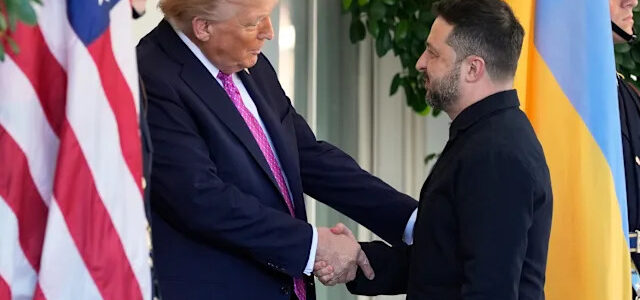
“Hopefully we’ll be able to get the war over without thinking about Tomahawks,” the president said.
President Trump equivocated on providing long-range Tomahawk missiles to Ukraine during a meeting with Ukrainian President Volodymyr Zelensky at the White House on Friday — suggesting instead that Russian President Vladimir Putin “wants to make a deal” and expressing optimism that there is now “momentum to finish Russia’s war against Ukraine” without explaining why he thinks an agreement is within reach.
“Hopefully they won’t need it,” Trump said when asked if he would send cruise missiles to Ukraine. “Hopefully we’ll be able to get the war over without thinking about Tomahawks.”

The president later added that Tomahawks are “a big deal” because they’re “a very dangerous weapon” that “could mean big, you know, escalation,” signaling doubts about involving the U.S. more deeply in the conflict.
Trump also said that the “problem” is “we need the Tomahawks” and other American-made weapons that have already been supplied to Ukraine.

“We don’t want to be giving away things that we need to protect our country,” he said.
Friday’s meeting between the two leaders — their sixth this year and third in the Oval Office — capped a coordinated effort by Zelensky and his European allies to sell Trump on their preferred strategy to end the war: fewer talks and more weapons to strike Russia and force Putin to finally negotiate in earnest.
Trump has renewed his focus on Ukraine and Russia after securing an open-ended ceasefire in the Gaza Strip last week, declaring on Monday that “we have to get Russia done.” A high-profile August summit with Putin in Alaska failed to produce any real results.
“Getting [the] Middle East done was very important,” the president said on Friday. “We got it done pretty swiftly after we set the table properly.”
“I think the table is set properly here now too,” Trump added.

The hope in Ukraine and across Europe is that U.S. Tomahawks — sophisticated missiles capable of precisely striking military and oil sites within Russia from 1,000 miles away — can accomplish what negotiations so far have not: making the war so costly for Putin that he eventually has to compromise with Zelensky. (Kyiv is less than 500 miles from Moscow.)
“The main task is to scale up our long-range Ukrainian sanctions capabilities,” Zelensky said on Wednesday, referring to potential missile strikes in economic terms.
“If this war doesn’t get settled, I may send Tomahawks,” Trump told reporters ahead of his Friday meeting with Zelensky. “A Tomahawk is an incredible weapon. And Russia does not need that. If the war is not settled, we may do it.”
On Friday, Trump didn’t rule out Tomahawks entirely; the Defense Department has reportedly drawn up plans to sell or transfer the missiles should Trump give the order. But his lack of commitment suggests that he would prefer to keep floating the possibility as a form of leverage over future talks rather than deciding one way or the other beforehand.
Such talks are set to take place soon. Alarmed by the possibility of what the Kremlin has described as “a serious escalation” in the war, Putin initiated a call with Trump on Thursday — ostensibly to “congratulate” the president on his “success” in Gaza, as Putin’s spokesman put it, but also to talk about missiles.
After the call, Trump acknowledged he had discussed the issue with Putin — and seemed to emphasize the downsides of sending Tomahawks to Ukraine, calling them “vicious, offensive, incredibly destructive weapon[s].” Trump then confirmed that he would meet separately with Putin and possibly Zelensky in Hungary “within two weeks or so.”
According to the New York Times, Putin’s call was the latest example of his so-called “Trump strategy.”
“He has invested dozens of hours into flattering Mr. Trump, dangling the prospect of Russian-American business deals and sending the message that Russia is open to talks to end its invasion,” the Times reported earlier this week. “The tactic has helped Mr. Putin head off repeated deadlines and sanction threats by the American president without curtailing Russia’s war effort.”
Asked on Friday if he was concerned that Putin is merely playing for time, Trump said, “Yeah, I am.” But then he shrugged off the potential implications.
“You know, I’ve been played all my life by the best of them, and I came out really well,” he insisted. “I think that he wants to make a deal.”
For his part, Zelensky disagreed with Trump’s assessment. “We want peace,” he said on Friday. “Putin doesn’t want [it]. That’s why we need pressure on him.”

Trump’s attitude toward the long-running conflict does seem to have shifted this year. He returned to office in January full of praise for Putin and reluctant to continue supporting Ukraine’s efforts to fend off the Russian invasion; within weeks, he paused U.S. assistance to Zelensky’s government.
But over the spring and summer, the president started to express frustration with Putin’s intensifying attacks on Ukrainian cities and civilians and his seeming indifference to peace talks.
When Russian missiles pounded Kyiv in late May, Trump accused Putin of “needlessly killing a lot of people,” adding in a social media post: “He has gone absolutely CRAZY!”
“I am very disappointed with President Putin,” Trump told reporters on July 13, shortly before announcing a plan to send weapons to Ukraine via NATO. “I thought he was somebody that meant what he said. And he’ll talk so beautifully and then he’ll bomb people at night. We don’t like that.”
In turn, Trump’s disappointment may have “pushed [him] into closer alignment with NATO allies and even Zelensky,” according to Politico. When little changed after the August summit with Putin, Trump publicly started to mull supplying Ukraine with more potent weapons.
“It’s like a great team in sports that has a fantastic defense, but is not allowed to play offense,” he wrote in August on social media. “There is no chance of winning! It is like that with Ukraine and Russia.”
The most recent Tomahawk missiles cost $2.5 million each and require a specialized launcher called Typhon. Ukraine hopes to use European money — via a new NATO-procurement system — to buy additional American weapons.
Credit: Yahoo News
